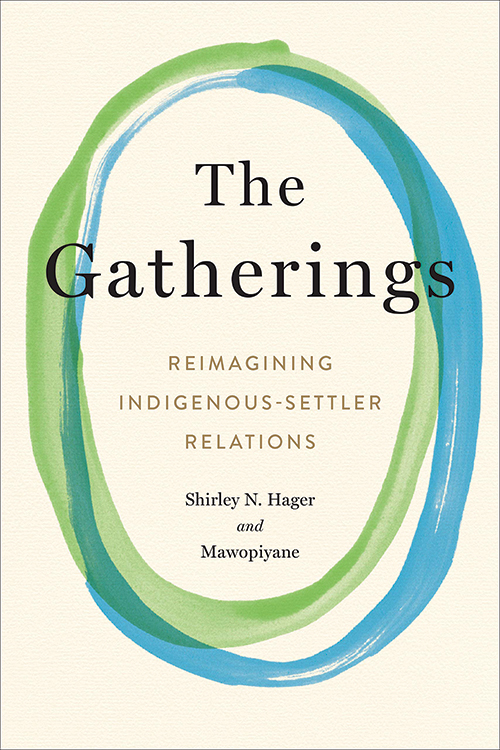
The Gatherings: Reimagining Indigenous–Settler Relations
Reviewed by David Etheridge
January 1, 2022
By Shirley N. Hager and Mawopiyane. Aevo UTP (University of Toronto Press), 2021. 304 pages. $29.95/hardcover or eBook.
The Gatherings: Reimagining Indigenous–Settler Relations was written by a group of 15 Natives and non-Natives describing their collaboration on issues affecting Wabanaki territory in Maine and the Canadian Maritimes beginning in 1987. The lead author is Shirley Hager, a New England Yearly Meeting Quaker.
Although the collaboration began in 1987 and is continuing today, the focus is on a series of meetings beginning in 1989 and ending in 1993. While the first two sessions were held in a retreat center and used a conference format familiar to most North Americans working in an academic or nonprofit setting, Native participants proposed that future sessions be held using a traditional Wabanaki format.
That format resembles the type of Quaker worship sharing where each Friend responds in turn to a query (or has the option to pass). The Wabanaki format involves passing a Talking Stick that entitles the holder to speak. As with Quaker worship sharing, there is no requirement to speak and speakers are expected to avoid addressing what others have said: no crosstalk. There are differences as well. The Wabanaki Circles begin with the ceremonial lighting of the Fire and the use of the Talking Stick. Quaker worship sharing is based on the explicit expectation that Friends will be listening for the Spirit—whether in the silence between messages or through the words of those who speak. The expectation of respectful listening is a feature of both.
Both Native and non-Native participants found that using the Wabanaki format contributed to the quality of their collaboration and to the bonding that occurred among them. The desire to share how that experience had worked for them motivated them to publish this book some 28 years after the gatherings ended.
The first half of the book, entitled “Gathering,” helps us experience what the Gatherings were like. Each participant tells their story in its own chapter. It is as if speakers pass the Talking Stick to the next person as their chapter ends and the next begins. The reader’s understanding builds as they hear from each speaker in turn.
The first half ends with recounting how the Gatherings stopped in response to objections from Native protestors who did not take part in the Gatherings. They saw the Gatherings as a form of cultural appropriation. The Gatherings’ participants tried unsuccessfully to persuade the protestors that what they were doing was respectful and mutual. A Native participant said she knew it was hard for the Native women protestors to stand up as they were doing. She thought she and others who took part in the Gatherings ought to honor and respect the protestors’ feelings, even if the participants were being misunderstood.
The second half is entitled “The Giveaway Blanket” named for the practice of laying out a blanket to receive gifts from each participant. Those participants then take a gift for themselves from the blanket. Each chapter in this section describes some learnings that came from participating in the Gatherings.
The gift described in the first chapter is the ceremony and the spirituality associated with the Gathering Circle itself. That chapter describes ambivalence within the Native community about sharing their practices with non-Natives. There is concern by some that non-Natives will exploit what they learn and be disrespectful. Some do want to share out of a spirit of generosity as well as pride in the value of their traditions. The chapter also describes non-Native concerns about receiving and enjoying the cultural sharing without engaging in cultural appropriation. The next chapter, “Allies, Friends, Family,” describes how the interpersonal relationships among the participants grew and evolved over time.
The third chapter, “How We Got Here,” is a brief survey of Native/non-Native relations beginning with the Doctrine of Discovery. The doctrine is based on fifteenth-century teachings of the Roman Catholic Church that Christian nations (mostly White at that time) had the right to rule over and dispossess non-Christian people they “discovered” in other parts of the world. Then the chapter focuses more closely on Native/non-Native interactions in Wabanaki territory.
In the final chapter, “How It Could Be Different,” the authors share the insights they have gained on how Natives and non-Natives can work well together by acknowledging First Peoples, honoring agreements, understanding their worldviews, and being in conversation with one another. The book includes a reader’s guide that would be helpful in a reading group.
David Etheridge is White, a member of Friends Meeting of Washington (D.C.), clerk of the Baltimore Yearly Meeting Working Group on Racism, and previously worked for over 20 years as an attorney in the Indian Affairs Division of the Solicitor’s Office of the U.S. Department of the Interior.


